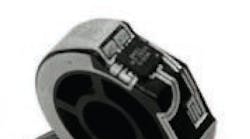In telecommunications systems, connector and equipment failures are only detected after tower capacity diminishes. The system then must be shut down to pinpoint the problem. As a result of this lag, deterioration and damage to cellular telecommunications cable assemblies cost organizations and customers millions in lost revenue and services. To alleviate the impact of these failures, researchers at the Rochester Institute of Technology (RIT; www.rit.edu) and PPC Corp. (www.ppc-online.com) have developed the Smart Connector. Once it is installed in the connecting units of coaxial cables, this connector can provide information about equipment damage. It also can pinpoint the exact location of that damage through self-diagnosing technologies.
Together with his research group, Robert BowmanProfessor of Electrical and Microelectronic Engineering in RIT's Kate Gleason College of Engineeringworked with Noah Montena, Principal Engineer at PPC, to design the sensor-disc system (see photo). The system monitors the primary failure modes in RF cables. Each sensor-disc contains a unique site identifier. A disc monitors critical conditions and reports the sensor status using backscatter telemetry. Notably, every smart connector is capable of activating or powering down its energy capacity by extracting miniscule amounts of RF energy from the coaxial cables.
Now that the university has demonstrated the feasibility of this technology, it is working with PPC to further test the manufactured product. The university and PPC Corp. signed a licensing agreement in June. This sensor is the result of corporate research and development initiatives established at RIT, which have grown over the past few years.

